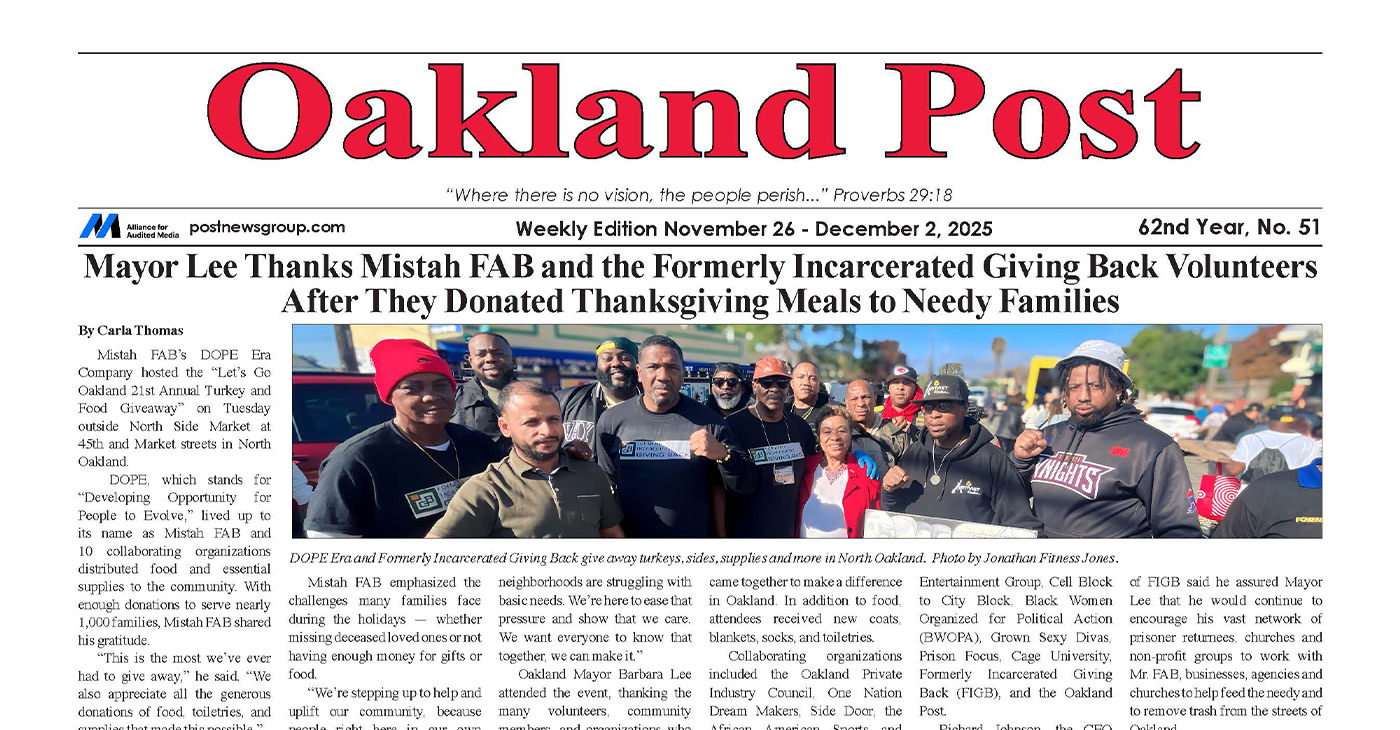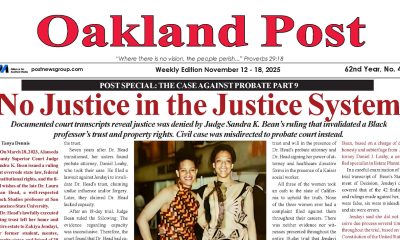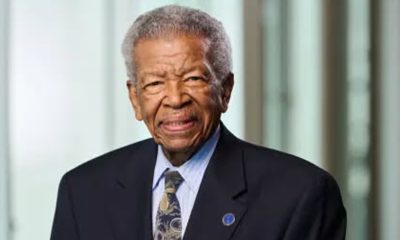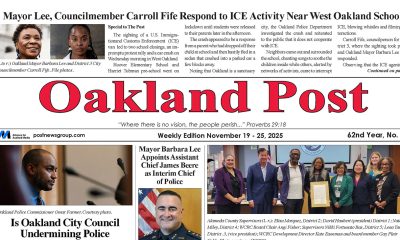Entertainment
Film Review: ‘Fast & Furious 7’
By Dwight Brown
NNPA Film Critic
Walking into a theater to see the latest Fast & Furious episode is like saying hello to an old, well-oiled friend. Great and familiar cast, excellent script, superb production values and the direction is tight as a drum. Can’t say this is the best film of the franchise, because so many of them have been excellent. But it’s easily the most daring. Fasten your seat belts and test the airbags. This one accelerates real fast.
Deckard Shaw (Jason Statham), a British black ops assassin, has a bug up his butt. Dominic Toretto (Vin Diesel) and his crew killed his brother and he is out for revenge. First stop is the office of CIA agent Luke Hobbs (Dwayne Johnson), where Shaw and Hobbs get into a fight that leaves the hulky agent broken. Next Shaw sends his blessings in the guise of a bomb to Dominic, his pal Brian (Paul Walker), his lady Mia (Jordana Brewster) and their kid. Kaboom!
Dom seeks answers. A government operative (Kurt Russell) has a plan. If Dom and his “family” hunt down a beta device called a Gods Eye, which is capable of tracking down anybody through aggregated surveillance cameras and audio feeds—even from cell phones, he’ll let them use it to catch Shaw. Says the operative, “It’s like a tracking device on steroids.” Says its inventor, Ramsey (Nathalie Emmanuel), “it uses every camera eye and audio device in this hemisphere.” And off they go, into battle. Dom and his crew and their vehicles. To the mountains of Eastern Europe, to Japan, the Middle East and L.A.
Director James Wan (Saw and The Conjuring) steps up to the camera along side cinematographers Marc Spicer and Stephen F. Windon (Fast & Furious 6) and displays an exceptional dexterity for car chases, fistfights and brawls. He uses a lot of close ups, and that filmmaking strategy drags you into the characters, their actions and the movie. With the aide of editors Leigh Folsom Boyd, Dylan Highsmith, Kirk M. Morri and Christian Wagner, he assembles adrenalin-pumping footage that is near perfectly paced for 140 minutes.
The action sequences are spellbinding. Cars jump out of planes, roll down mountains, are pummeled by missiles and skid through buildings. The car crew jumps out of moving trucks onto cars, drive super charged classic cars and evade gunshots. Punches are thrown, tire irons swung and machine guns are wielded around like toys. There is a precision to the proceedings that is astounding, invigorating and over the top.
Screenwriter Chris Morgan, who penned four previous chapters, knows the drill. Personal drama (there are some awkward sentimental moments that linger too long), romance (Diesel and Michelle Rodriguez rekindle the love story between Dom and Letty), intrigue, revenge, evil doings, retribution and the final fight and chase scenes. He doesn’t let the characters evolve much, compared to the originally one conjured by Gary Scott Thompson in 2001. He’s more faithful to their personalities, relationships and group dynamics. There are millions of fans waiting for whiney Roman (Tyrese Gibson) to crack jokes and Tej (Ludacris) to have a tech solution for a problem, and Morgan doesn’t disappoint.
The direction, production elements and writing wouldn’t mean a thing if the cast wasn’t on their game, and they are. They’ve aged; fuller faces, softer muscles, and maybe they’ve slowed down a step or two. Diesel is laconic, strong, the alpha. Johnson has his customary bravura. Rodriguez has that perfect blend of strong Latina and vulnerable woman. Statham is a worthy villain. Kurt Russell is a welcome addition. If you didn’t know that Paul Walker had passed, you couldn’t guess from what’s on view that his work, stand-ins, his brother and movie magic filled out his entire role in the movie. It’s easy to see that this film is a homage to his spirit.
It’s hard to say this is the best action film every made, but worth that debate.
This spring when you walk into your theater to see Fast & Furious 7, you will walk out thinking you just saw the first blockbuster event movie of the summer – only it isn’t summer yet.
Wanna go for a ride?
Visit NNPA Film Critic Dwight Brown at DwightBrownInk.com.
Activism
Oakland Post: Week of December 10 – 16, 2025
The printed Weekly Edition of the Oakland Post: Week of – December 10 – 16, 2025

To enlarge your view of this issue, use the slider, magnifying glass icon or full page icon in the lower right corner of the browser window.
Alameda County
Seth Curry Makes Impressive Debut with the Golden State Warriors
Seth looked comfortable in his new uniform, seamlessly fitting into the Warriors’ offensive and defensive system. He finished the night with an impressive 14 points, becoming one of the team’s top scorers for the game. Seth’s points came in a variety of ways – floaters, spot-up three-pointers, mid-range jumpers, and a handful of aggressive drives that kept the Oklahoma City Thunder defense on its heels.

By Y’Anad Burrell
Tuesday night was anything but ordinary for fans in San Francisco as Seth Curry made his highly anticipated debut as a new member of the Golden State Warriors. Seth didn’t disappoint, delivering a performance that not only showcased his scoring ability but also demonstrated his added value to the team.
At 35, the 12-year NBA veteran on Monday signed a contract to play with the Warriors for the rest of the season.
Seth looked comfortable in his new uniform, seamlessly fitting into the Warriors’ offensive and defensive system. He finished the night with an impressive 14 points, becoming one of the team’s top scorers for the game. Seth’s points came in a variety of ways – floaters, spot-up three-pointers, mid-range jumpers, and a handful of aggressive drives that kept the Oklahoma City Thunder defense on its heels.
One of the most memorable moments of the evening came before Seth even scored his first points. As he checked into the game, the Chase Center erupted into applause, with fans rising to their feet to give the newest Warrior a standing ovation.
The crowd’s reaction was a testament not only to Seth’s reputation as a sharpshooter but also to the excitement he brings to the Warriors. It was clear that fans quickly embraced Seth as one of their own, eager to see what he could bring to the team’s championship aspirations.
Warriors’ superstar Steph Curry – Seth’s brother – did not play due to an injury. One could only imagine what it would be like if the Curry brothers were on the court together. Magic in the making.
Seth’s debut proved to be a turning point for the Warriors. Not only did he contribute on the scoreboard, but he also brought a sense of confidence and composure to the floor.
While their loss last night, OKC 124 – GSW 112, Seth’s impact was a game-changer and there’s more yet to come. Beyond statistics, it was clear that Seth’s presence elevated the team’s performance, giving the Warriors a new force as they look to make a deep playoff run.
Activism
Oakland Post: Week of November 26 – December 2, 2025
The printed Weekly Edition of the Oakland Post: Week of November 26 – December 2, 2025

To enlarge your view of this issue, use the slider, magnifying glass icon or full page icon in the lower right corner of the browser window.
-

 Activism4 weeks ago
Activism4 weeks agoOakland Post: Week of November 12 – 18, 2025
-

 Activism3 weeks ago
Activism3 weeks agoIN MEMORIAM: William ‘Bill’ Patterson, 94
-

 Activism4 weeks ago
Activism4 weeks agoHow Charles R. Drew University Navigated More Than $20 Million in Fed Cuts – Still Prioritizing Students and Community Health
-

 Bay Area4 weeks ago
Bay Area4 weeks agoNo Justice in the Justice System
-

 #NNPA BlackPress3 weeks ago
#NNPA BlackPress3 weeks agoBeyoncé and Jay-Z make rare public appearance with Lewis Hamilton at Las Vegas Grand Prix
-

 #NNPA BlackPress3 weeks ago
#NNPA BlackPress3 weeks agoLewis Hamilton set to start LAST in Saturday Night’s Las Vegas Grand Prix
-

 Activism3 weeks ago
Activism3 weeks agoOakland Post: Week of November 19 – 25, 2025
-

 #NNPA BlackPress4 weeks ago
#NNPA BlackPress4 weeks agoThe Perfumed Hand of Hypocrisy: Trump Hosted Former Terror Suspect While America Condemns a Muslim Mayor












































